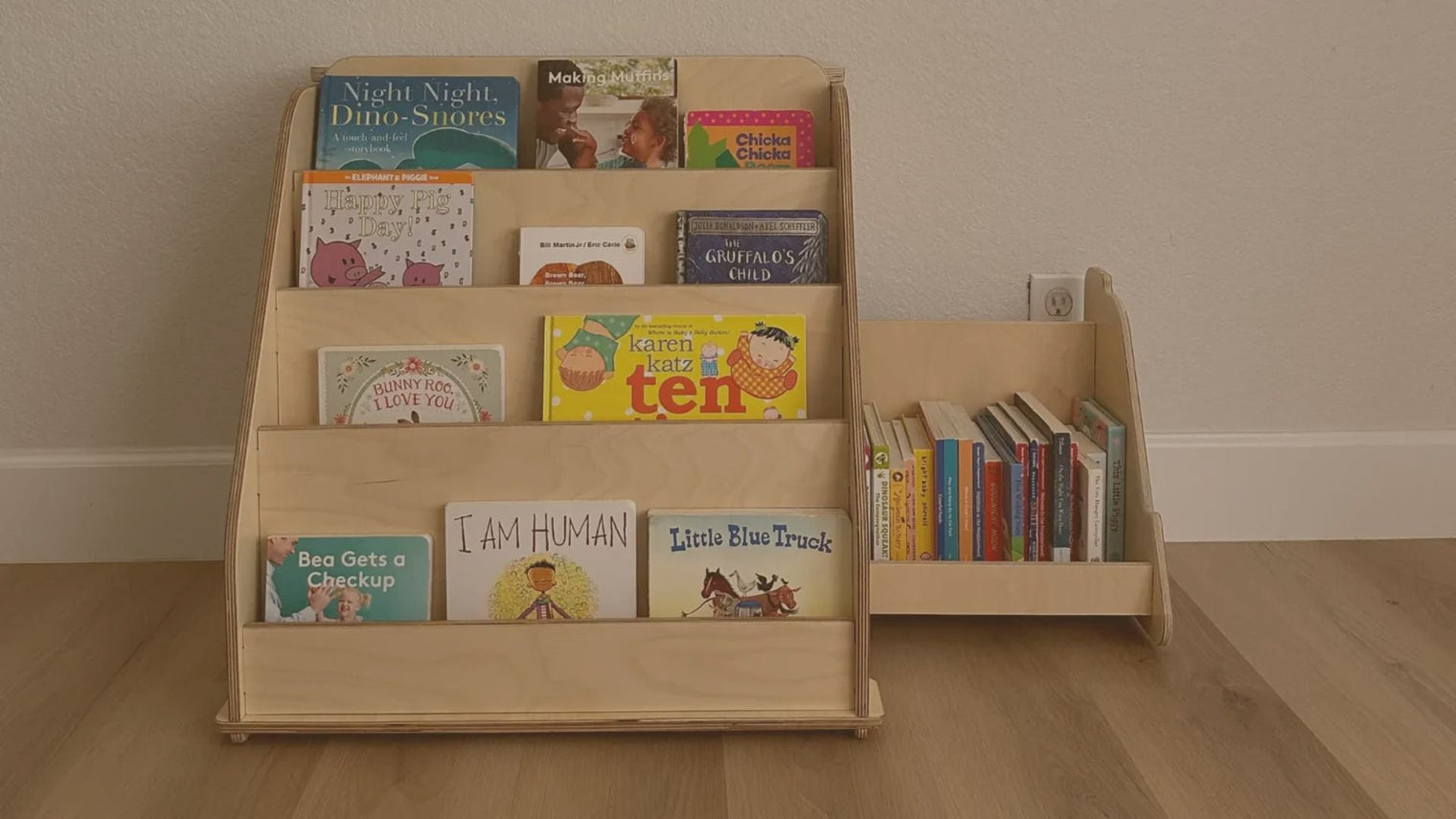A thoughtfully arranged Montessori bookshelf can transform your child's relationship with reading and learning.
As parents, we often underestimate how the presentation of books impacts a child's engagement and independence. In a world where screens compete for attention, creating an inviting book display has never been more crucial.
At Dannico Woodworks, we believe that the right environment fosters natural curiosity and a love for learning.
Our journey began with a simple realization: children thrive when given the tools to explore independently.
This guide will help you create a Montessori bookshelf that not only looks beautiful but actively invites your child to engage, discover, and grow.
Understanding Montessori Bookshelves
Montessori bookshelves differ significantly from traditional book storage. Unlike conventional bookcases where books are stacked with spines out, Montessori shelves feature front-facing displays that make book covers fully visible.
This design choice is intentional—it allows children to see the entire cover art, making selections based on visual interest rather than just reading titles.
The benefits of this approach extend beyond aesthetics. When children can easily see and access books independently, they develop decision-making skills and take ownership of their reading choices.
This autonomy builds confidence and fosters a genuine interest in books rather than making reading feel like a chore imposed by adults.
At Dannico Woodworks, our Montessori-inspired shelves are designed at child height, eliminating the need for adult assistance.
This accessibility is fundamental to the Montessori philosophy of "help me do it myself."
By removing physical barriers, we create opportunities for children to engage with materials on their own terms, developing both literacy skills and independence simultaneously.
Key Principles for Styling a Montessori Bookshelf
Front-Facing Display
The most distinctive feature of Montessori bookshelves is the front-facing presentation. This allows children to judge books by their covers—not in a superficial sense, but by connecting with the illustrations and themes that spark their curiosity.
When styling your shelf, ensure each book is fully visible, not partially hidden behind others.
Limited Selection
Resist the temptation to display every book you own. A carefully curated selection of 8-12 books prevents overwhelm and allows children to focus their attention.
This limitation actually encourages deeper engagement with fewer titles rather than superficial browsing of many.
Rotating Materials
Keep the display fresh by rotating books every 1-2 weeks. This maintains interest while reintroducing favorites that may have been temporarily out of sight.
Rotation also allows you to align the book selection with seasonal themes, current interests, or learning objectives.
Accessibility
Arrange books with the child's height and reach in mind. Place favorite or frequently chosen books at eye level, with less familiar titles slightly above or below.
Ensure the shelf itself is stable and at an appropriate height for the child to use independently.
Organization and Categorization
Group books by theme, author, or reading level to help children develop classification skills.
This organization makes the shelf visually appealing while teaching early concepts of categorization that support cognitive development.
Step-by-Step Guide to Styling for Maximum Engagement
Step 1: Curating the Right Books and Materials
Begin by selecting a diverse range of books that reflect your child's current interests while introducing new concepts and perspectives. Include a mix of fiction and non-fiction, various genres, and different reading levels. Consider books that:
- Represent diverse characters and experiences
- Align with your child's current passions or questions
- Introduce new vocabulary or concepts
- Feature beautiful, engaging illustrations
- Are developmentally appropriate
At Dannico Woodworks, we recommend including not just books but other engaging materials like puzzles, small art supplies, or nature specimens. This variety encourages different types of exploration and keeps the shelf dynamic and interesting.
Step 2: Arrangement Techniques
How you arrange the books significantly impacts engagement. Try these techniques:
- Place the most visually appealing books at eye level
- Create small groupings of 2-3 related books
- Alternate between displaying books horizontally and vertically
- Leave some space to avoid a cluttered appearance
- Position books with covers facing completely forward, not angled
Consider the flow of the shelf arrangement—your eye should naturally move from one section to another, creating a visual journey that invites exploration.
Step 3: Creating Themed Displays
Themed displays create excitement and contextual learning. Some ideas include:
- Seasonal themes (books about autumn, winter, etc.)
- Color-based arrangements
- Author spotlights featuring several books by the same writer
- Subject-specific displays (dinosaurs, space, emotions)
- Holiday or special event collections
Themed displays make the shelf feel new and exciting, even if some books have been seen before. This approach also helps children make connections between different books and concepts.
Step 4: Incorporating Variety Beyond Books
A truly engaging Montessori shelf includes more than just books. Consider adding:
- Small baskets with themed objects (toy animals, natural materials)
- Simple art supplies and paper
- Puzzles or manipulatives
- Picture cards or flashcards
- Small plants or natural specimens
- Child-friendly magazines or catalogs
This variety acknowledges that learning happens through multiple mediums and allows children to engage with literacy in different ways.
Step 5: Rotation Schedule and Maintenance
Establish a regular rotation schedule to keep the display fresh. Many parents find that bi-weekly rotations work well, though you may adjust based on your child's engagement level. When rotating:
- Observe which books your child gravitates toward and keep some favorites
- Introduce 2-3 new books each rotation
- Remove books that haven't been chosen recently
- Clean the shelf and repair any damaged books
- Consider your child's recent questions or interests when selecting new additions
Maintenance also involves regularly checking that books are in good condition and that the shelf itself remains stable and secure.
Age-Specific Considerations
Toddlers (1-3 years)
For this age group, focus on:
- Board books with sturdy pages
- Simple, clear illustrations
- Books about daily routines, emotions, and basic concepts
- Interactive elements (lift-the-flap, touch-and-feel)
- Very limited selection (6-8 books maximum)
- Lower shelf height for easy access
Preschoolers (3-5 years)
Preschoolers benefit from:
- Longer picture books with engaging stories
- Books about friendships, nature, and expanding experiences
- Simple non-fiction books about topics of interest
- Rhyming books and those with repetitive text
- 8-10 books displayed with some thematic grouping
- Introduction of simple chapter books for read-alouds
Early Elementary (5-8 years)
For this developmental stage, consider:
- Beginning reader books alongside more complex picture books
- Non-fiction books on specific interests
- Simple chapter books or early graphic novels
- Books that reflect their expanding world and experiences
- 10-12 books with more complex categorization
- Opportunities for the child to help select and arrange books
FAQs
How much space do I need for a Montessori bookshelf?
Montessori bookshelves come in various sizes. Even a small wall-mounted ledge can work in tight spaces. The key is accessibility and visibility, not necessarily size. Dannico Woodworks offers compact designs perfect for apartments and smaller homes.
Are Montessori bookshelves expensive?
While some high-end options exist, there are Montessori-style shelves available at various price points. Remember that you're investing in your child's independence and relationship with reading. At Dannico Woodworks, we offer durable options that grow with your child, providing long-term value.
How do I prevent my child from pulling all the books off at once?
This is common initially! Model gentle handling, limit the number of books displayed, and involve your child in the organization process. Over time, they learn to respect the materials and engage more purposefully.
Can I use a regular bookshelf as a Montessori shelf?
You can adapt a traditional shelf by adding book displays or bins that allow front-facing presentation.
However, purpose-built Montessori shelves are typically sized appropriately for children and designed with accessibility in mind.
Conclusion
A thoughtfully styled Montessori bookshelf does more than organize books—it creates an invitation to explore, learn, and grow independently.
By applying these principles of curation, display, and rotation, you transform a simple piece of furniture into a powerful tool for your child's development.
At Dannico Woodworks, we understand that the environment we create for our children shapes their relationship with learning. Our shelves are designed not just to store books, but to inspire young minds.
What story will your child discover next on their journey to independent learning?
We invite you to explore our collection of Montessori-inspired furniture, crafted to support your child's natural curiosity and love for discovery.

